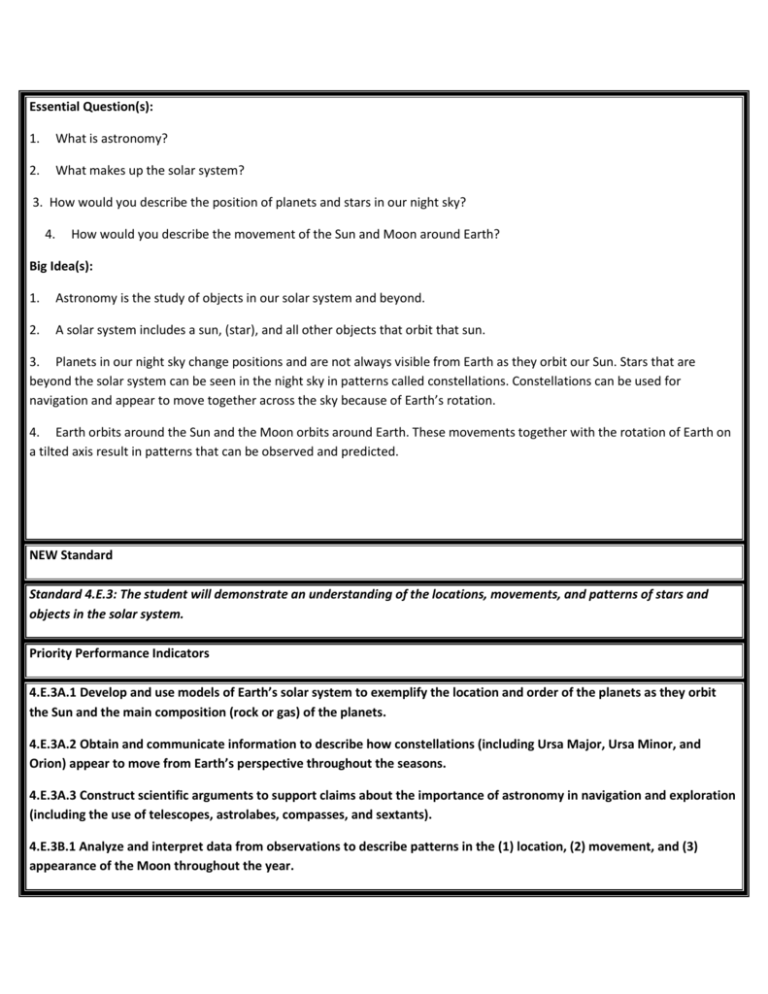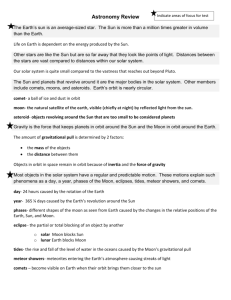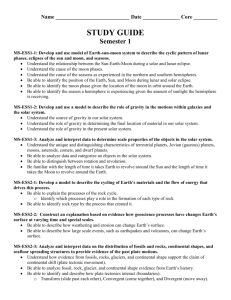Essential Question(s): 1. What is astronomy? 2. What makes up the
advertisement

Essential Question(s): 1. What is astronomy? 2. What makes up the solar system? 3. How would you describe the position of planets and stars in our night sky? 4. How would you describe the movement of the Sun and Moon around Earth? Big Idea(s): 1. Astronomy is the study of objects in our solar system and beyond. 2. A solar system includes a sun, (star), and all other objects that orbit that sun. 3. Planets in our night sky change positions and are not always visible from Earth as they orbit our Sun. Stars that are beyond the solar system can be seen in the night sky in patterns called constellations. Constellations can be used for navigation and appear to move together across the sky because of Earth’s rotation. 4. Earth orbits around the Sun and the Moon orbits around Earth. These movements together with the rotation of Earth on a tilted axis result in patterns that can be observed and predicted. NEW Standard Standard 4.E.3: The student will demonstrate an understanding of the locations, movements, and patterns of stars and objects in the solar system. Priority Performance Indicators 4.E.3A.1 Develop and use models of Earth’s solar system to exemplify the location and order of the planets as they orbit the Sun and the main composition (rock or gas) of the planets. 4.E.3A.2 Obtain and communicate information to describe how constellations (including Ursa Major, Ursa Minor, and Orion) appear to move from Earth’s perspective throughout the seasons. 4.E.3A.3 Construct scientific arguments to support claims about the importance of astronomy in navigation and exploration (including the use of telescopes, astrolabes, compasses, and sextants). 4.E.3B.1 Analyze and interpret data from observations to describe patterns in the (1) location, (2) movement, and (3) appearance of the Moon throughout the year. 4.E.3B.2 Construct explanations of how day and night result from Earth’s rotation on its axis. 4.E.3B.3 Construct explanations of how the Sun appears to move throughout the day using observations of shadows. 4.E.3B.4 Develop and use models to describe the factors (including tilt, revolution, and angle of sunlight) that result in Earth’s seasonal changes. OLD STANDARDS - SAME CONTENT 4-3.1 Recall that Earth is one of many planets in the solar system that orbit the Sun. It is essential for students to know that Earth is a planet that orbits around the Sun. There are also other planets that also orbit the Sun; some are closer to the Sun than Earth and others are farther away. Some are small, rocky planets like Earth (Mercury, Venus, Mars); some are large planets with a surface made of gas (Jupiter, Saturn, Neptune, Uranus) unlike Earth. Planets Planets are bodies, natural satellites, that orbit the Sun, a star. Earth Earth is the third planet from the Sun in the solar system Sun The Sun is the name for the central star in our solar system. The sequence of the named planets from the Sun outward is also part of this recall. 4-3.2 Compare the properties (including the type of surface and atmosphere) and the location of Earth to the Sun, which is a star, and the Moon. It is essential for students to know that even though the Sun, the Moon and Earth are all in the solar system, they have different properties. Earth · Earth has a rocky surface as a planet and also has water on it. · It has an atmosphere of gases around it. · It orbits millions of miles from the Sun as the third planet in the solar system. Sun · The Sun is a star, a large ball of glowing gases that is extremely hot. · It does not have a rocky surface and its atmosphere glows and gives off light. · It is located at the center of the solar system. · Earth and other planets revolve around it. Moon · The Moon is the natural satellite that orbits the Earth. · It has a rocky, dusty surface with many craters and no water. · It has no atmosphere. It is essential for students to know that the Sun as a star produces heat and light deep down inside of it. · The Sun produces and gives off its own heat and light. · Earth receives that heat and light after they travel through space. · The Sun is the source of almost all energy on Earth: · Plants take the Sun’s energy and use it to make food energy. · The Sun’s energy causes weather conditions on Earth. · Heat from the Sun causes the process of evaporation of water on Earth’s surface. · The Sun’s energy is stored in fossil fuels (for example, coal, oil, or natural gas) that formed from some organisms that died long ago. 4-3.4 Explain how the tilt of Earth’s axis and the revolution around the Sun results in the seasons of the year. It is essential for students to know that Earth has distinct seasons which result from the tilt of its axis and its revolution around the Sun. · Earth revolves around the Sun one time each year in about 365 days. · Earth has seasons because Earth’s axis is tilted. · Because of the tilt, the number of daylight hours changes throughout the year. · As Earth revolves around the Sun, different parts of Earth get more sunlight. · The tilt also causes the northern or the southern part of Earth, to point toward the Sun. · When the tilt is toward the Sun, the season is summer; when the tilt is away from the Sun, the season is winter. · The two hemispheres have opposite seasons. · The seasons do NOT depend on the distance of Earth from the Sun. Axis · Earth rotates around an imaginary straight line called an axis that runs through the planet’s center. Revolution · The movement of Earth as it makes an orbit around the Sun in one year. Seasons · The effects on Earth due to the change in the amount of sunlight caused by the tilt of Earth’s axis. o Summer occurs when part of Earth is tilted most toward the Sun o Autumn and spring occur when neither part of Earth is pointed directly toward or away from the Sun. o Winter occurs when part of Earth is tilted away from the Sun. o The sequence of the seasons during the year is summer, autumn/fall, winter, and then spring. 4-3.5 Explain how the rotation of Earth results in day and night. It is essential for students to know that: · Earth rotates (spins) on its axis and completes one rotation in 24 hours. · Earth rotates from west to east, therefore, the Sun appears to rise in the east and set in the west. · Because of this rotation, only the side of Earth facing the Sun is lit and therefore experiences day; the side of Earth not facing the Sun experiences night. 4-3.6 Illustrate the phases of the Moon and the Moon’s effect on ocean tides. It is essential for students to know that the Moon reflects light from the Sun and just like Earth, half of the Moon is always lit by the Sun. · Because of the positions of the Sun, the Moon, and Earth, the Moon appears to change shape. · The amount of reflected light from the Moon that is seen from Earth determines the phase. · The changing shapes of the Moon are called phases. There are four main phases: o New moon – the entire half/side of the Moon facing Earth is dark. o Quarter moon – half of the side of the Moon facing Earth is lighted and the other half is dark; the Moon appears as a half circle; there are two quarter moon phases in the cycle. NOTE TO TEACHER: Students may see the name also as Half moon. o Full moon – the entire half/side of the Moon facing Earth is lighted; the Moon appears as a full circle. o Crescent moon – a small section (less than a quarter moon) of the half/side of the Moon facing Earth is lighted. · The change in the Moon’s phases from new moon to new moon takes about four weeks, 29½ days. It is essential for students to know that the Moon and Earth pull on each other because of gravity. · The Moon’s pull on Earth makes the surface level of the ocean rise and fall; this change in level is called tide: · High tide is when the ocean water level is the highest; there are two high tides each day. · Low tides occur between high tides. 4-3.7 Interpret the change in the length of shadows during the day in relation to the position of the Sun in the sky. It is essential for students to know that objects on Earth cast shadows that help show Earth’s rotation. The angle of the Sun, low in the sky to higher in the sky, changes the length of the shadow cast behind an object. · In the morning, the Sun appears low in the sky; objects cast long shadows. · As Earth rotates, the Sun’s appears higher in the sky, and the shadows get shorter. · At noon, with the Sun overhead, objects cast short shadows or no shadow at all. · As Earth continues to rotate and the Sun appears lower in the sky toward evening, the shadows get longer again. 4-3.8 Recognize The Purpose of Telescopes It is essential for students to know that telescopes are tools that aid in the study of objects in outer space. · A telescope can gather more light than the eye, so it makes faint, faraway objects seem brighter and closer.








